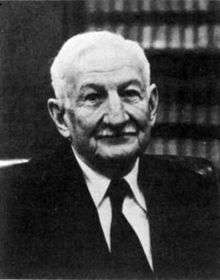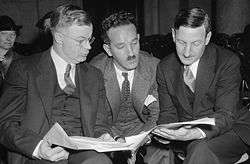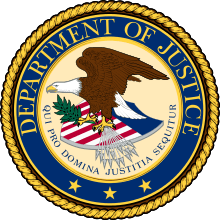Charles Fahy
| Charles Fahy | |
|---|---|
 | |
| Judge of the United States Court of Appeals for the District of Columbia Circuit | |
|
In office April 7, 1950 – April 17, 1967 | |
| Nominated by | Harry S. Truman |
| Preceded by | Seat established |
| Succeeded by | George MacKinnon |
| 26th Solicitor General of the United States | |
|
In office November 1, 1941 – September 1945 | |
| Appointed by | Franklin Roosevelt |
| Preceded by | Francis Biddle |
| Succeeded by | J. Howard McGrath |
| Personal details | |
| Born |
Charles Fahy August 17, 1892 Rome, Georgia, U.S. |
| Died |
September 17, 1979 (aged 87) Washington, D.C., U.S. |
| Spouse(s) |
Mary Agnes Lane (m. 1929) |
| Alma mater |
Notre Dame (A.B.) Georgetown University Law School (LL.B.) |
Charles Fahy (August 27, 1892 – September 17, 1979) was an American lawyer and jurist who served as Solicitor General of the United States and later as a United States federal judge on the United States Court of Appeals for the District of Columbia Circuit.
Background
Born in Rome, Georgia, Fahy was the son of Thomas and Sarah (Jonas) Fahy.[1] Charles attended the University of Notre Dame and then went to Georgetown University Law School.[2][1] There he received his LL.B. in 1914,[3][4][5] and was admitted to the D.C. bar in the same year.[6][7] He then engaged in private practice in Washington, D.C., including criminal defense in capital cases.[8][9]
Career
From August 1917 to January 1918, Fahy served the United States in World War I as a naval aviator attached to the British and American forces.[10] Fahy was awarded the Navy Cross.[11] After the war he returned to Washington, D.C. and practiced law until 1924,[12][13][14] before moving his practice to Santa Fe, New Mexico, where he resided until 1933. While in Sante Fe, Fahy served as the city attorney in 1932.
Executive branch service

In 1933, Fahy returned to Washington when he was appointed first assistant solicitor to the Department of the Interior. The same year, he was appointed as a member of the Petroleum Administrative Board, and then served as its president from 1934-1935. As general counsel of the National Labor Relations Board from 1935–1940, Fahy began his career in Supreme Court litigation on behalf of labor rights. Upon the enactment of the Wagner Act in 1935, Fahy, on behalf of the NLRB, often appeared in front of both Houses of Congress to offer testimony and litigated cases in the Supreme Court brought against the government. By the time he was appointed assistant solicitor general in 1940, Fahy had already appeared eighteen times in front of the Supreme Court, where his arguments were wholly sustained sixteen times and partially upheld twice.
Fahy was appointed Solicitor General by President Franklin D. Roosevelt on November 1, 1941. While Solicitor General, Fahy continued to advocate for worker's labor rights, and was involved in cases regarding the constitutionality of wiretapping and the citizenship of American Communists.
Fahy served as Solicitor General until 1945, after having argued more than 70 cases in front of the Supreme Court before being called upon by General Dwight D. Eisenhower to serve as director of the legal division of the U.S. Group Control Council in Germany in the aftermath of World War II. After returning from his tour of duty in Germany, Fahy became the Legal Adviser of the Department of State. He was also a member of the U.S. Legal Committee of the United Nations General Assembly held in New York City in 1946.
Japanese American internment cases
Fahy defended the government in four cases that challenged aspects of internment of Japanese Americans during World War II. During preparations for the Hirabayashi v. United States and Yasui v. United States in 1943, Assistant Attorney General Edward Ennis presented Fahy with a Naval Intelligence report from 1942 that recommended limited internment of Japanese Americans over mass confinement.[15] The plaintiffs in both cases had been arrested and convicted for violating the curfew and exclusion orders related to Executive Order 9066, and both men separately filed appeals that eventually landed in the Supreme Court. Ennis urged Fahy to submit the ONI report as evidence, but because it directly contradicted the Western Defense Command's argument that it was impossible to determine Japanese American loyalty on an individual basis, Fahy withheld the information and won both cases.[16][17][18] He also successfully argued the landmark case of Korematsu v. United States in 1944, in which the Supreme Court validated the constitutionality of the executive and military orders forcing the relocation of Japanese Americans into camp. Ennis and other aides brought to Fahy's attention FBI and FCC reports that disproved the claims of Japanese American sabotage key to the government's argument; Fahy inserted an ambiguously worded footnote in his court brief that did not specifically mention the contradicting evidence, and the Court ruled against Korematsu.[16][18][19] The fourth case, Ex parte Endo, was decided in the plaintiff's favor and effectively ended the incarceration.[20][21]
In the 1980s, researchers Peter Irons and Aiko Herzig-Yoshinaga uncovered evidence that Fahy deliberately suppressed information indicating Japanese Americans were not a threat to national security, and the Korematsu, Yasui, and Hirabayashi convictions were all overturned.[22] In 2011, Acting Solicitor General Neal Katyal formally acknowledged Fahy's misconduct in the cases.[23][24] Alternatively, Charles J. Sheehan, Fahy's grandson, argues that his grandfather did not withhold evidence.[25]
Federal judicial service
Fahy returned to private practice in 1947, but was again called to serve the federal government as chairman of the President's Committee on Equality of Treatment and Opportunities in Armed Forces, from 1948-1950. On October 21, 1949, Fahy received a recess appointment from Harry S Truman to a new seat on the United States Court of Appeals for the D.C. Circuit created by 63 Stat. 493. Formally nominated on January 5, 1950, Fahy was confirmed by the United States Senate on April 4, 1950, and received his commission on April 7, 1950. He assumed senior status on April 17, 1967, and served in that capacity until his death.
Hiss Case involvement
In August–September 1948, he was one of many prominent lawyers who advised Alger Hiss on whether to file a defamation suit against Whittaker Chambers after Chambers stated on NBC Radio's Meet the Press that Hiss had been a Communist.[26] Writing to his lifelong friend and fellow Harvard lawyer William L. Marbury, Jr., Hiss wrote in 1948:
I am planning a suit for libel or defamation... The number of volunteer helpers is considerable: Freddy Pride of Dwight, Harris, Koegel & Casking (the offshoot of young Charles Hughes' firm), Fred Eaton of Shearman and Sterling, Eddie Miller of Mr. Dulles' firm, Marshall McDuffie, now no longer a lawyer; in Washington Joe Tumulty, Charlie Fahy, Alex Hawes, John Ferguson (Mr. Ballantine's son-in-law) and others–but the real job is get general overall counsel and that fortunately is now settled, but we must move swiftly as so far the committee with its large investigating staff and considerable resources has been able to seize the initiative continuously and regularly. Everyone has been most helpful...[26]
Death and commemoration

Fahy was the recipient of a number of awards, including the Navy Cross (1917), a medal for military merit (1946), the Robert S. Abbott Memorial Award (1951), John Carroll Award from the Georgetown University Member Alumni (1953), and the D.C. Distinguished Service Award (1969). Charles Fahy died on September 17, 1979, at the age of 87 in Washington, D.C. He was survived by his wife Mary Agnes Lane, whom he married June 26, 1929, in Washington, D.C., and children Charles (Dom Thomas Fahy O.S.B.), Anne Marie (Sheehan), Sarah Agnes (Sister Sarah Fahy S.N.D.), and Mary Agnes (Johnson).
References
- 1 2 Newman, Roger K. (2009). The Yale Biographical Dictionary of American Law. New Haven, CT: Yale University Press. p. 191. ISBN 0300113005. Retrieved September 29, 2017.
- ↑ "Alumni of Notre Dame Banquet College Team". Evening star. (Washington, D.C.). Library of Congress Historic Newspapers. May 16, 1912. p. 24. Retrieved September 29, 2017.
- ↑ "To Confer Law Degrees". Evening star. (Washington, D.C.). Library of Congress Historic Newspapers. June 3, 1912. p. 20. Retrieved September 29, 2017.
- ↑ "Four Hundred Get College Degrees". Evening star. (Washington, D.C.). Library of Congress Historic Newspapers. June 16, 1914. p. 3. Retrieved September 29, 2017.
- ↑ "Georgetown U. Graduates 417". The Washington herald. Library of Congress Historic Newspapers. June 17, 1914. p. 2. Retrieved September 29, 2017.
- ↑ "153 New Lawyers Admitted to the Bar". Evening star. (Washington, D.C.). Library of Congress Historic Newspapers. October 6, 1914. p. 11. Retrieved September 29, 2017.
- ↑ "The Courts, Court of Appeals". Evening star. (Washington, D.C.). Library of Congress Historic Newspapers. October 13, 1914. p. 18. Retrieved September 29, 2017.
Charles Fahy...admitted to practice
- ↑ "The Courts, District Supreme Court, Probate Court". Evening star. (Washington, D.C.). Library of Congress Historic Newspapers. December 15, 1914. p. 19. Retrieved September 29, 2017.
- ↑ "City News in Brief". Evening star. (Washington, D.C.). Library of Congress Historic Newspapers. April 3, 1917. p. 3. Retrieved September 29, 2017.
Howard Moore, colored, who pleaded guilty to manslaughter...Attorney Charles Fahy appeared for prisoner.
- ↑ "Charles Fahy, Aviator, Honored". Evening star. (Washington, D.C.). Library of Congress Historic Newspapers. January 24, 1919. p. 10. Retrieved September 29, 2017.
- ↑ Silber, Norman Isaac (2004). With All Deliberate Speed: The Life of Philip Elman: an Oral History Memoir. Ann Arbor, MI: University of Michigan Press. p. 141. ISBN 0472114255. Retrieved September 29, 2017.
- ↑ "Own Lies Trapped Wan, Says Laws". The Washington times. Library of Congress Historic Newspapers. January 8, 1920. p. 2. Retrieved September 29, 2017.
- ↑ "Will Not Grant Retrial for Wan". Evening star. (Washington, D.C.). Library of Congress Historic Newspapers. May 7, 1920. p. 2. Retrieved September 29, 2017.
- ↑ "Mattingly Urges Speeding Courts". Evening star. (Washington, D.C.). Library of Congress Historic Newspapers. January 6, 1924. p. 13. Retrieved September 29, 2017.
- ↑ Yamamoto, Eric K.; Chon, Margaret; Izumi, Carol L.; Kang, Jerry; Wu, Frank H. Race, Rights and Reparation: Law and the Japanese American Internment (New York: Aspen Law & Business, 2001), pp 306-07.
- 1 2 Niiya, Brian. "Charles Fahy". Densho Encyclopedia. Retrieved 21 August 2014.
- ↑ Irons, Peter. Justice at War: The Story of the Japanese American Internment Cases (Berkeley: University of California Press, 1983), pp 195-98, 202-07.
- 1 2 Irons. A People's History of the Supreme Court (New York: Penguin Books, 1999), pp 362-63.
- ↑ Irons. Justice at War, pp 285-86.
- ↑ Irons. Justice at War, pp 318-19, 324.
- ↑ Yamamoto, et al. Race, Rights and Reparation, p 169.
- ↑ Niiya, Brian. "Coram nobis cases". Densho Encyclopedia. Retrieved 21 August 2014.
- ↑ Savage, David G. (May 24, 2011). "U.S. official cites misconduct in Japanese American internment cases". Los Angeles Times.
- ↑ Russo, Tracy (May 20, 2011). "Confession of Error: The Solicitor General's Mistakes During the Japanese-American Internment Cases". The Justice Blog. Department of Justice. Archived from the original on 19 February 2013. Retrieved 25 June 2013.
- ↑ Sheehan, Charles J. "Solicitor General Charles Fahy and Honorable Defense of the Japanese-American Exclusion Cases", American Journal of Legal History (54:4), October 2014. Also see Peter Irons, "How Solicitor General Charles Fahy Misled the Supreme Court in the Japanese American Internment Cases: A Reply to Charles Sheehan," American Journal of Legal History, Vol. 55, pp. 208–226 (April 2015). Irons discounts the objectivity of Charles Sheehan, noting he is Fahy's grandson. The Department of Justice and the Solicitor General's Office have not changed their position on Fahy's misconduct. Additionally, see Charles Sheehan's reply: "Charles Fahy, 'Brilliant Public Service as Solicitor General,' A Reply to Peter Irons", American Journal of Legal History, Vol. 55, Issue 3 (September 2015). (The quote regarding Charles Fahy's "Brilliant Public Service as Solicitor General" is from Justice William J. Brennan, "Charles Fahy", 54 Georgetown Law Journal 1 (1964–65)).
- 1 2 Hiss, Alger (31 August 1948), (Letter to William Marbury), Maryland Historical Socity, retrieved 29 September 2017
![]()
External sources
- Finding Aid to the Papers of Charles Fahy (PDF). The Library of Congress.
- Charles Fahy Solicitor General. U.S. Department of Justice.
- Fahy, Charles. Federal Judicial Center - Biographical Directory of Federal Judges.
- Charles Fahy at the U.S. Supreme Court. Oyez.com.
- Charles Fahy at Find a Grave

| Legal offices | ||
|---|---|---|
| Preceded by new seat |
Judge of the United States Court of Appeals for the District of Columbia Circuit 1950–1967 |
Succeeded by George MacKinnon |
| Preceded by Green Hackworth |
Legal Adviser of the Department of State 1946 – 1947 |
Succeeded by Ernest A. Gross |
| Preceded by Francis Biddle |
Solicitor General 1941–1945 |
Succeeded by J. Howard McGrath |
